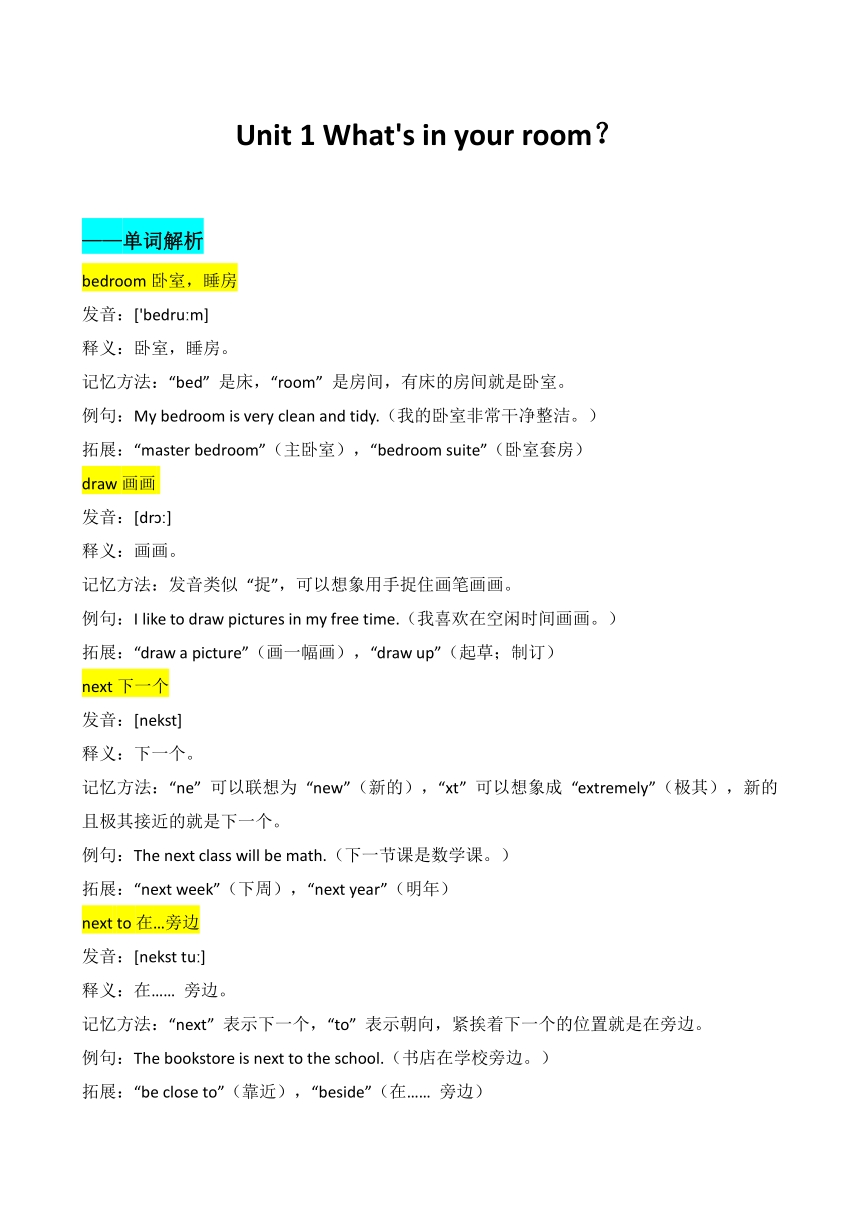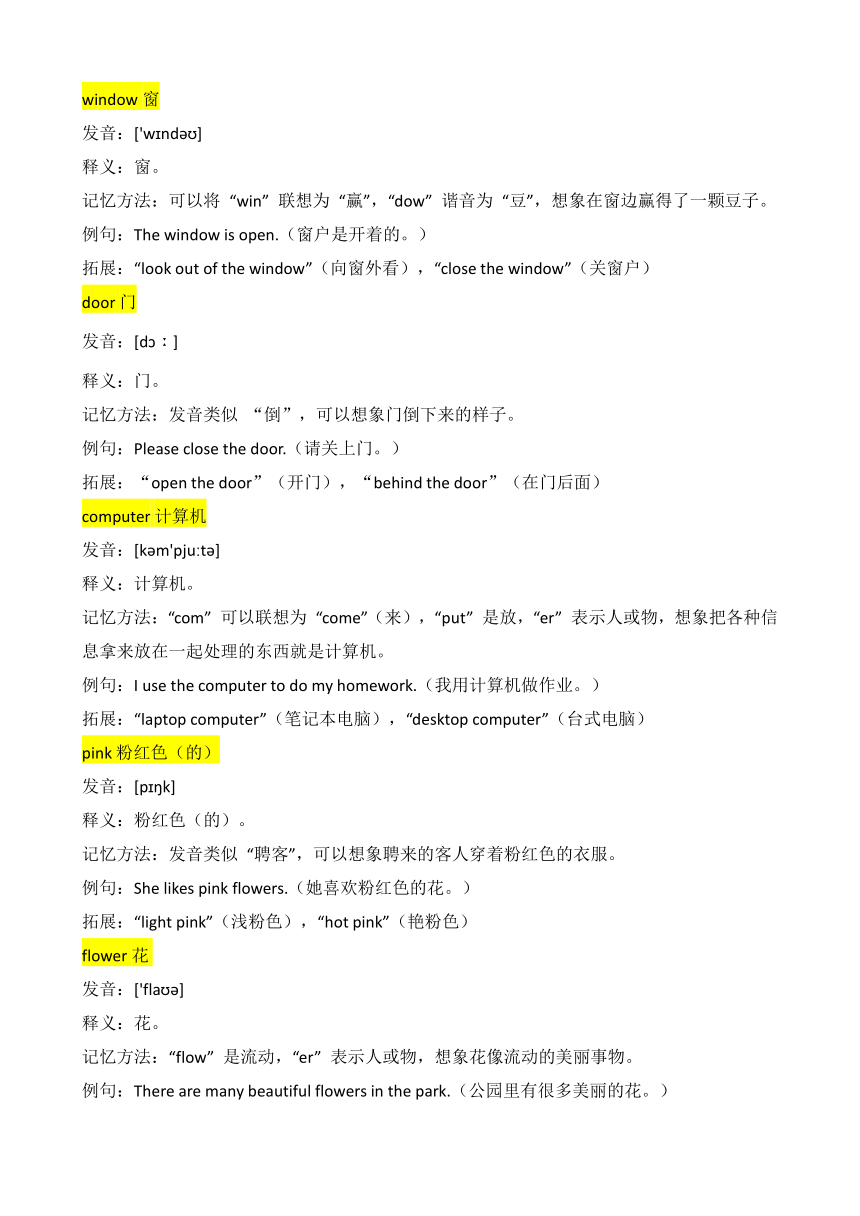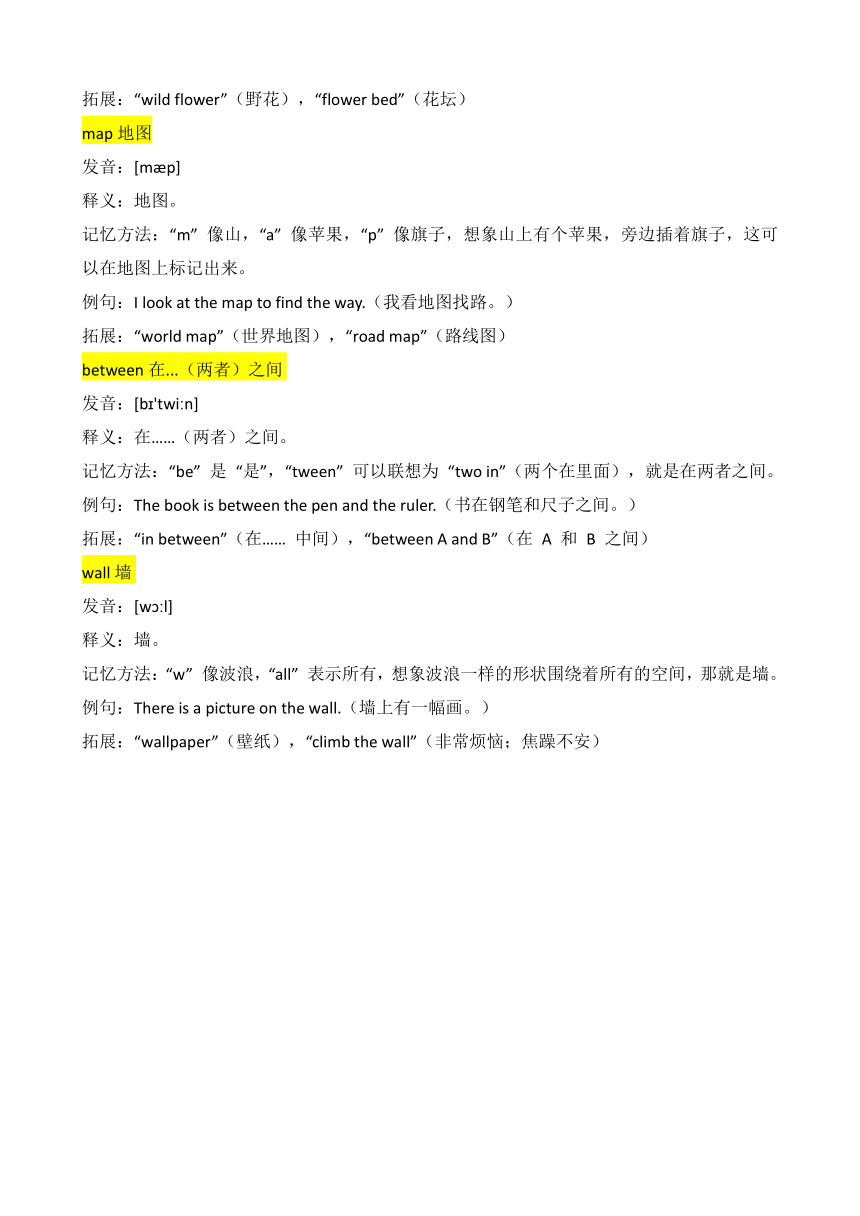Module 1 Unit 1 What's in your room 单词解析+重点考点
文档属性
| 名称 | Module 1 Unit 1 What's in your room 单词解析+重点考点 |  | |
| 格式 | docx | ||
| 文件大小 | 23.4KB | ||
| 资源类型 | 教案 | ||
| 版本资源 | 教科版(广州) | ||
| 科目 | 英语 | ||
| 更新时间 | 2024-09-30 13:42:14 | ||
图片预览




文档简介
Unit 1 What's in your room?
——单词解析
bedroom卧室,睡房
发音:['bedru m]
释义:卧室,睡房。
记忆方法:“bed” 是床,“room” 是房间,有床的房间就是卧室。
例句:My bedroom is very clean and tidy.(我的卧室非常干净整洁。)
拓展:“master bedroom”(主卧室),“bedroom suite”(卧室套房)
draw画画
发音:[dr ]
释义:画画。
记忆方法:发音类似 “捉”,可以想象用手捉住画笔画画。
例句:I like to draw pictures in my free time.(我喜欢在空闲时间画画。)
拓展:“draw a picture”(画一幅画),“draw up”(起草;制订)
next下一个
发音:[nekst]
释义:下一个。
记忆方法:“ne” 可以联想为 “new”(新的),“xt” 可以想象成 “extremely”(极其),新的且极其接近的就是下一个。
例句:The next class will be math.(下一节课是数学课。)
拓展:“next week”(下周),“next year”(明年)
next to在…旁边
发音:[nekst tu ]
释义:在…… 旁边。
记忆方法:“next” 表示下一个,“to” 表示朝向,紧挨着下一个的位置就是在旁边。
例句:The bookstore is next to the school.(书店在学校旁边。)
拓展:“be close to”(靠近),“beside”(在…… 旁边)
window窗
发音:['w nd ]
释义:窗。
记忆方法:可以将 “win” 联想为 “赢”,“dow” 谐音为 “豆”,想象在窗边赢得了一颗豆子。
例句:The window is open.(窗户是开着的。)
拓展:“look out of the window”(向窗外看),“close the window”(关窗户)
door 门
发音:[d ]
释义:门。
记忆方法:发音类似 “倒”,可以想象门倒下来的样子。
例句:Please close the door.(请关上门。)
拓展:“open the door”(开门),“behind the door”(在门后面)
computer 计算机
发音:[k m'pju t ]
释义:计算机。
记忆方法:“com” 可以联想为 “come”(来),“put” 是放,“er” 表示人或物,想象把各种信息拿来放在一起处理的东西就是计算机。
例句:I use the computer to do my homework.(我用计算机做作业。)
拓展:“laptop computer”(笔记本电脑),“desktop computer”(台式电脑)
pink 粉红色(的)
发音:[p k]
释义:粉红色(的)。
记忆方法:发音类似 “聘客”,可以想象聘来的客人穿着粉红色的衣服。
例句:She likes pink flowers.(她喜欢粉红色的花。)
拓展:“light pink”(浅粉色),“hot pink”(艳粉色)
flower花
发音:['fla ]
释义:花。
记忆方法:“flow” 是流动,“er” 表示人或物,想象花像流动的美丽事物。
例句:There are many beautiful flowers in the park.(公园里有很多美丽的花。)
拓展:“wild flower”(野花),“flower bed”(花坛)
map地图
发音:[m p]
释义:地图。
记忆方法:“m” 像山,“a” 像苹果,“p” 像旗子,想象山上有个苹果,旁边插着旗子,这可以在地图上标记出来。
例句:I look at the map to find the way.(我看地图找路。)
拓展:“world map”(世界地图),“road map”(路线图)
between在...(两者)之间
发音:[b 'twi n]
释义:在……(两者)之间。
记忆方法:“be” 是 “是”,“tween” 可以联想为 “two in”(两个在里面),就是在两者之间。
例句:The book is between the pen and the ruler.(书在钢笔和尺子之间。)
拓展:“in between”(在…… 中间),“between A and B”(在 A 和 B 之间)
wall墙
发音:[w l]
释义:墙。
记忆方法:“w” 像波浪,“all” 表示所有,想象波浪一样的形状围绕着所有的空间,那就是墙。
例句:There is a picture on the wall.(墙上有一幅画。)
拓展:“wallpaper”(壁纸),“climb the wall”(非常烦恼;焦躁不安)
——重点考点
【重点考点一】句型What’s in...
这是一个特殊疑问句。
“What” 是特殊疑问词,用于询问事物,在这个句型中用来询问某个地方内部存在的东西,What's =What is。
“is” 是 be 动词的第三人称单数形式,根据主语的不同,be 动词会有相应变化(如 “What are in...” 用于复数主语的情况)。
“in” 是方位介词,表示 “在…… 里面”,后面通常接表示地点的名词或代词,in可换成其它介词(如on、behind、under……)。
其答语要用There is/are ...
如:
—What’s on the bed —There is a bag.
—What is behind the door —There are two books.
【重点考点二】be动词的用法
be动词分为:am、 is、 are
用法口诀:
我(I)用am; 你(you)用are;is连着他(he)/她(she)/它(it);复数全用are。
如:
I am a boy. Are you a boy , too
我是个男孩,你也是男孩吗?
He is a teacher.
他是一名老师。
These two dogs are brown.
这两只狗是棕色的。
【重点考点三】方位介词
①on 表示“在...上面”,强调两者互相接触
如:
The cup is on the desk.
杯子在书桌上。
②in表示“在...里面”
如:
The book is in the box.
书在盒子里。
③near表示“在...附近”
如:
There is a pen near the bag.
书包附近有一支钢笔。
④under表示“在...下面”
如:
There is a cat under the chair.
猫在椅子下面。
⑤behind表示“在...后面”
如:
There is a map behind the door.
门后有一张地图。
⑥in front of表示“在...前面”
如:
There is a big tree in front of the house.
房子前面有一棵大树。
⑦next to... 紧挨着,靠近
如:
There is a bed next to the window.
有一张床紧挨着窗户。
⑧between 在 ... 与 ... 之间 (强调两者)
常用结构:between ... and ...
如:
There is a book between the bag and the box.
在书包与盒子之间,有一本书。
⑨beside 在....旁边
如:
There is a picture beside the pencil.
铅笔旁边有一幅画。
【重点考点四】句型What colour is/are ...
What colour is/are ... 用来询问某物的颜色,其中 “is” 用于单数可数名词或者不可数名词, “are” 用于复数可数名词。
如:
—What colour is your computer —It is pink.
—What colour are the apples —They are red.
【重点考点五】There be句型
①定义:表示某处存在某物/某人。
There is a toy car on the desk.
↓ ↓
某物 某处
翻译:书桌上有一个玩具车。
②结构
1)be动词要与后面名词主语的数保持一致。(is +单数可数名词/不可数名词;are +复数名词)
如:
There is a map on the wall.
墙上有一幅地图。
There are two maps on the wall.
墙上有两幅地图。
2)当有两个或两个以上的名词时,be动词要与跟它最近的那个名词的数保持一致,叫做就近原则。
如:
There are two boys and a girl under the tree. (two boys 距离be动词最近)
There is a girl and two boys under the tree. (a girl 距离be动词最近)
③句型转换
1)变成否定句:在be动词后加上not即可。
如:
There is a bike behind the tree.→变否:There is not a bike behind the tree.
>肯定句中如果含有some,在变成否定句时,要把some变any
如:
There are some pictures on the wall.→变否:There are not any pictures on the wall.
2)变成一般疑问句:把be动词调整到句首,句号变问号。
There is a book in the bag .→变疑:Is there a book in the bag
>但同时要注意:当肯定句中有some时,变为一般疑问句时,要将some变为any。
There are some books in the bag .→变疑:Are there any books in the bag
3)特殊疑问句
1>对主语提问:当主语是人的时候,则用who 引导;当主语是物的时候,则用what引导。
注意:无论原句的主语是单数还是复数,对之提问时一般都用be的单数形式,回答时却要根据实际情况来决定。
如:
My mother is in the room (对划线部分提问)→Who is in the room
There are some books on the desk.(对划线部分提问)→What is on the desk
2>对地点进行提问,则用where 引导。
如:
The computer is on the desk.(对划线部分提问)→ Where is the computer
3>对可数名词的数量进行提问,则用How many
如:
There are five people in the room.(对划线部分提问)→How many people are there in the room
④ there be与have/has的用法区别
there be表示 “存在有”,强调某地有某物或某人,There be + 名词 +其它;
have/has表示 “拥有”,强调某人或某物 “拥有” 什么东西,主语 + have/has + 其它,它的主语通常是有生命的人或动物,也可以是表示组织、团体等的名词
如:
There are some apples in the box.
盒子里有一些苹果。
We have some apples.
我们有一些苹果。
⑤have/has跟主语的搭配使用
口诀:我(I)你(you)我们(we)他们(they)都用 have,他(he)她(she)它(it)单个名儿用 has,其中,has用于主语三单,have用于主语非三单。
而have的第三人称单数形式是:has
如:
I have a book.
You have a book.
They have some books.
(主语I/You/They是非三单)
He has a book.
My mother has a book.
The cat has big eyes.
(主语He/My mother/The cat是三单)
【重点考点六】want,动词,表示想...
①want (sb.) to do sth ,想要(某人)做某事
如:
I want to draw a picture.
我想画一幅画。
②want + 名词,想要某物
如:
I want an banana.
我想要一条香蕉。
——单词解析
bedroom卧室,睡房
发音:['bedru m]
释义:卧室,睡房。
记忆方法:“bed” 是床,“room” 是房间,有床的房间就是卧室。
例句:My bedroom is very clean and tidy.(我的卧室非常干净整洁。)
拓展:“master bedroom”(主卧室),“bedroom suite”(卧室套房)
draw画画
发音:[dr ]
释义:画画。
记忆方法:发音类似 “捉”,可以想象用手捉住画笔画画。
例句:I like to draw pictures in my free time.(我喜欢在空闲时间画画。)
拓展:“draw a picture”(画一幅画),“draw up”(起草;制订)
next下一个
发音:[nekst]
释义:下一个。
记忆方法:“ne” 可以联想为 “new”(新的),“xt” 可以想象成 “extremely”(极其),新的且极其接近的就是下一个。
例句:The next class will be math.(下一节课是数学课。)
拓展:“next week”(下周),“next year”(明年)
next to在…旁边
发音:[nekst tu ]
释义:在…… 旁边。
记忆方法:“next” 表示下一个,“to” 表示朝向,紧挨着下一个的位置就是在旁边。
例句:The bookstore is next to the school.(书店在学校旁边。)
拓展:“be close to”(靠近),“beside”(在…… 旁边)
window窗
发音:['w nd ]
释义:窗。
记忆方法:可以将 “win” 联想为 “赢”,“dow” 谐音为 “豆”,想象在窗边赢得了一颗豆子。
例句:The window is open.(窗户是开着的。)
拓展:“look out of the window”(向窗外看),“close the window”(关窗户)
door 门
发音:[d ]
释义:门。
记忆方法:发音类似 “倒”,可以想象门倒下来的样子。
例句:Please close the door.(请关上门。)
拓展:“open the door”(开门),“behind the door”(在门后面)
computer 计算机
发音:[k m'pju t ]
释义:计算机。
记忆方法:“com” 可以联想为 “come”(来),“put” 是放,“er” 表示人或物,想象把各种信息拿来放在一起处理的东西就是计算机。
例句:I use the computer to do my homework.(我用计算机做作业。)
拓展:“laptop computer”(笔记本电脑),“desktop computer”(台式电脑)
pink 粉红色(的)
发音:[p k]
释义:粉红色(的)。
记忆方法:发音类似 “聘客”,可以想象聘来的客人穿着粉红色的衣服。
例句:She likes pink flowers.(她喜欢粉红色的花。)
拓展:“light pink”(浅粉色),“hot pink”(艳粉色)
flower花
发音:['fla ]
释义:花。
记忆方法:“flow” 是流动,“er” 表示人或物,想象花像流动的美丽事物。
例句:There are many beautiful flowers in the park.(公园里有很多美丽的花。)
拓展:“wild flower”(野花),“flower bed”(花坛)
map地图
发音:[m p]
释义:地图。
记忆方法:“m” 像山,“a” 像苹果,“p” 像旗子,想象山上有个苹果,旁边插着旗子,这可以在地图上标记出来。
例句:I look at the map to find the way.(我看地图找路。)
拓展:“world map”(世界地图),“road map”(路线图)
between在...(两者)之间
发音:[b 'twi n]
释义:在……(两者)之间。
记忆方法:“be” 是 “是”,“tween” 可以联想为 “two in”(两个在里面),就是在两者之间。
例句:The book is between the pen and the ruler.(书在钢笔和尺子之间。)
拓展:“in between”(在…… 中间),“between A and B”(在 A 和 B 之间)
wall墙
发音:[w l]
释义:墙。
记忆方法:“w” 像波浪,“all” 表示所有,想象波浪一样的形状围绕着所有的空间,那就是墙。
例句:There is a picture on the wall.(墙上有一幅画。)
拓展:“wallpaper”(壁纸),“climb the wall”(非常烦恼;焦躁不安)
——重点考点
【重点考点一】句型What’s in...
这是一个特殊疑问句。
“What” 是特殊疑问词,用于询问事物,在这个句型中用来询问某个地方内部存在的东西,What's =What is。
“is” 是 be 动词的第三人称单数形式,根据主语的不同,be 动词会有相应变化(如 “What are in...” 用于复数主语的情况)。
“in” 是方位介词,表示 “在…… 里面”,后面通常接表示地点的名词或代词,in可换成其它介词(如on、behind、under……)。
其答语要用There is/are ...
如:
—What’s on the bed —There is a bag.
—What is behind the door —There are two books.
【重点考点二】be动词的用法
be动词分为:am、 is、 are
用法口诀:
我(I)用am; 你(you)用are;is连着他(he)/她(she)/它(it);复数全用are。
如:
I am a boy. Are you a boy , too
我是个男孩,你也是男孩吗?
He is a teacher.
他是一名老师。
These two dogs are brown.
这两只狗是棕色的。
【重点考点三】方位介词
①on 表示“在...上面”,强调两者互相接触
如:
The cup is on the desk.
杯子在书桌上。
②in表示“在...里面”
如:
The book is in the box.
书在盒子里。
③near表示“在...附近”
如:
There is a pen near the bag.
书包附近有一支钢笔。
④under表示“在...下面”
如:
There is a cat under the chair.
猫在椅子下面。
⑤behind表示“在...后面”
如:
There is a map behind the door.
门后有一张地图。
⑥in front of表示“在...前面”
如:
There is a big tree in front of the house.
房子前面有一棵大树。
⑦next to... 紧挨着,靠近
如:
There is a bed next to the window.
有一张床紧挨着窗户。
⑧between 在 ... 与 ... 之间 (强调两者)
常用结构:between ... and ...
如:
There is a book between the bag and the box.
在书包与盒子之间,有一本书。
⑨beside 在....旁边
如:
There is a picture beside the pencil.
铅笔旁边有一幅画。
【重点考点四】句型What colour is/are ...
What colour is/are ... 用来询问某物的颜色,其中 “is” 用于单数可数名词或者不可数名词, “are” 用于复数可数名词。
如:
—What colour is your computer —It is pink.
—What colour are the apples —They are red.
【重点考点五】There be句型
①定义:表示某处存在某物/某人。
There is a toy car on the desk.
↓ ↓
某物 某处
翻译:书桌上有一个玩具车。
②结构
1)be动词要与后面名词主语的数保持一致。(is +单数可数名词/不可数名词;are +复数名词)
如:
There is a map on the wall.
墙上有一幅地图。
There are two maps on the wall.
墙上有两幅地图。
2)当有两个或两个以上的名词时,be动词要与跟它最近的那个名词的数保持一致,叫做就近原则。
如:
There are two boys and a girl under the tree. (two boys 距离be动词最近)
There is a girl and two boys under the tree. (a girl 距离be动词最近)
③句型转换
1)变成否定句:在be动词后加上not即可。
如:
There is a bike behind the tree.→变否:There is not a bike behind the tree.
>肯定句中如果含有some,在变成否定句时,要把some变any
如:
There are some pictures on the wall.→变否:There are not any pictures on the wall.
2)变成一般疑问句:把be动词调整到句首,句号变问号。
There is a book in the bag .→变疑:Is there a book in the bag
>但同时要注意:当肯定句中有some时,变为一般疑问句时,要将some变为any。
There are some books in the bag .→变疑:Are there any books in the bag
3)特殊疑问句
1>对主语提问:当主语是人的时候,则用who 引导;当主语是物的时候,则用what引导。
注意:无论原句的主语是单数还是复数,对之提问时一般都用be的单数形式,回答时却要根据实际情况来决定。
如:
My mother is in the room (对划线部分提问)→Who is in the room
There are some books on the desk.(对划线部分提问)→What is on the desk
2>对地点进行提问,则用where 引导。
如:
The computer is on the desk.(对划线部分提问)→ Where is the computer
3>对可数名词的数量进行提问,则用How many
如:
There are five people in the room.(对划线部分提问)→How many people are there in the room
④ there be与have/has的用法区别
there be表示 “存在有”,强调某地有某物或某人,There be + 名词 +其它;
have/has表示 “拥有”,强调某人或某物 “拥有” 什么东西,主语 + have/has + 其它,它的主语通常是有生命的人或动物,也可以是表示组织、团体等的名词
如:
There are some apples in the box.
盒子里有一些苹果。
We have some apples.
我们有一些苹果。
⑤have/has跟主语的搭配使用
口诀:我(I)你(you)我们(we)他们(they)都用 have,他(he)她(she)它(it)单个名儿用 has,其中,has用于主语三单,have用于主语非三单。
而have的第三人称单数形式是:has
如:
I have a book.
You have a book.
They have some books.
(主语I/You/They是非三单)
He has a book.
My mother has a book.
The cat has big eyes.
(主语He/My mother/The cat是三单)
【重点考点六】want,动词,表示想...
①want (sb.) to do sth ,想要(某人)做某事
如:
I want to draw a picture.
我想画一幅画。
②want + 名词,想要某物
如:
I want an banana.
我想要一条香蕉。
同课章节目录
- Module 1 My bedroom
- Unit 1 What's in your room?
- Unit 2 They're near the window
- Module 2 My house
- Unit 3 Welcome to my house
- Unit 4 I live in a big house
- Module 3 My school
- Unit 5 Let me show you our new school
- Unit 6 How many classrooms are there in your schoo
- Module 4 My class
- Unit 7 How many stars does each group have?
- Unit 8 I like English best
- Module 5 Clothes
- Unit 9 Look at this T-shirt
- Unit 10 Can I help you?
- Module 6 Occupations
- Unit 11 I want to be a painter
- Unit 12 What's your father's job?
- Module 7 Let's look back
